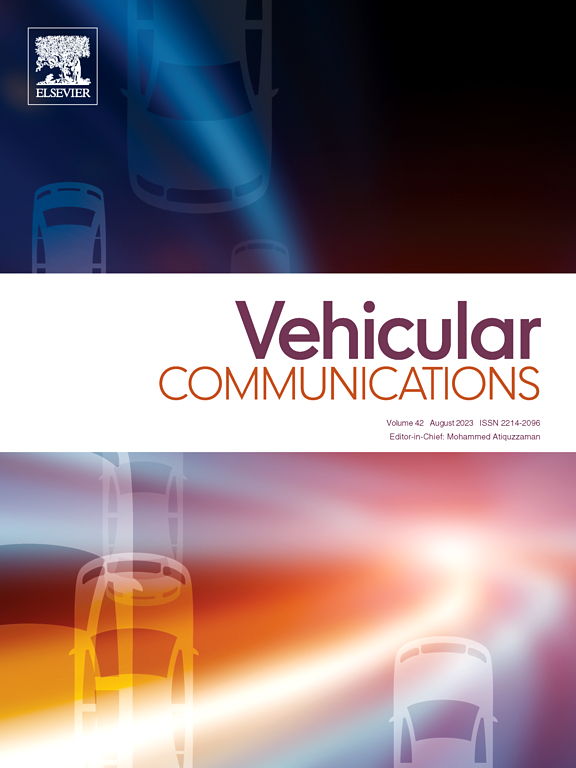EGBCR-FANET:基于增强成吉思汗鲨鱼优化器的贝叶斯驱动的fanet聚类路由模型
IF 6.5
2区 计算机科学
Q1 TELECOMMUNICATIONS
引用次数: 0
摘要
无人机(UAV)技术发展迅速,在军事和商业领域都有广泛的应用。结果,多无人机网络,也被称为飞行自组织网络(fanet),已经成为当前通信系统的一个重要部分。然而,fanet面临着能源资源有限、移动性高、拓扑变化频繁、通信链路不一致等诸多挑战。这些困难影响网络的稳定性,限制数据传输效率,缩短网络寿命。解决这些问题需要在fanet中采用适应性强的路由策略。无人机中基于集群的路由是一种节省能源、增加可扩展性和提高网络性能的好方法。介绍了一种基于增强型成吉思汗鲨鱼优化器(EGKSO)的fanet聚类和路由框架。与以前的聚类方法不同,建议的解决方案在考虑节点覆盖率和网络带宽的同时动态选择适当数量的集群。利用EGKSO算法选择节能且稳定的簇头,实现负载均衡分配,延长网络寿命。为了保证网络的稳定性和保持高效的通信性能,提出了一种动态集群维护技术。此外,提出了一种贝叶斯启发的自适应路由下一跳选择模型,使概率决策能够有效地响应网络变化。这种群体智能和概率建模的结合提高了通信可靠性,减少了延迟,并最大化了能源效率。仿真结果表明,该方法在投递率、能耗、时延和聚类稳定性等方面都优于现有的聚类和路由协议。结果证明了将基于元启发式的聚类与贝叶斯启发的路由相结合的有效性,为动态和资源受限环境下的fanet提供了弹性和可扩展的解决方案。本文章由计算机程序翻译,如有差异,请以英文原文为准。
EGBCR-FANET: Enhanced genghis Khan shark optimizer based Bayesian-driven clustered routing model for FANETs
Unmanned Aerial Vehicle (UAV) technology has advanced rapidly, with broad use in both the military and commercial sectors. As a result, multi-UAV networks, also known as Flying Ad Hoc Networks (FANETs), have become a vital part of current communication systems. However, FANETs confront numerous challenges such as limited energy resources, high mobility, frequent topological changes, and inconsistent communication links. These difficulties influence network stability, limit data transmission efficiency, and shorten network longevity. Addressing these issues requires an adaptable routing strategy in FANETs. Cluster-based routing in UAVs is a great way to save energy, increase scalability, and improve network performance. This paper introduces a new clustering and routing framework for FANETs based on the Enhanced Genghis Khan Shark Optimizer (EGKSO). Unlike previous clustering approaches, the suggested solution dynamically selects the appropriate number of clusters while taking node coverage and network bandwidth into account. EGKSO is used to choose energy-efficient and stable cluster heads, resulting in balanced load distribution and a longer network lifetime. A dynamic cluster maintenance technique is proposed to ensure network stability and maintain efficient communication performance. In addition, a Bayesian-inspired next-hop selection model for adaptive routing is presented, allowing probabilistic decision-making to respond to network changes efficiently. This combination of swarm intelligence and probabilistic modeling improves communication reliability, reduces latency, and maximizes energy efficiency. The simulation results show that the suggested method outperforms existing clustering and routing protocols in terms of delivery ratio, energy consumption, latency, and clustering stability. The results demonstrate the efficacy of combining metaheuristic-based clustering with Bayesian-inspired routing, providing a resilient and scalable solution for FANETs in dynamic and resource-constrained contexts.
求助全文
通过发布文献求助,成功后即可免费获取论文全文。
去求助
来源期刊

Vehicular Communications
Engineering-Electrical and Electronic Engineering
CiteScore
12.70
自引率
10.40%
发文量
88
审稿时长
62 days
期刊介绍:
Vehicular communications is a growing area of communications between vehicles and including roadside communication infrastructure. Advances in wireless communications are making possible sharing of information through real time communications between vehicles and infrastructure. This has led to applications to increase safety of vehicles and communication between passengers and the Internet. Standardization efforts on vehicular communication are also underway to make vehicular transportation safer, greener and easier.
The aim of the journal is to publish high quality peer–reviewed papers in the area of vehicular communications. The scope encompasses all types of communications involving vehicles, including vehicle–to–vehicle and vehicle–to–infrastructure. The scope includes (but not limited to) the following topics related to vehicular communications:
Vehicle to vehicle and vehicle to infrastructure communications
Channel modelling, modulating and coding
Congestion Control and scalability issues
Protocol design, testing and verification
Routing in vehicular networks
Security issues and countermeasures
Deployment and field testing
Reducing energy consumption and enhancing safety of vehicles
Wireless in–car networks
Data collection and dissemination methods
Mobility and handover issues
Safety and driver assistance applications
UAV
Underwater communications
Autonomous cooperative driving
Social networks
Internet of vehicles
Standardization of protocols.
 求助内容:
求助内容: 应助结果提醒方式:
应助结果提醒方式:


